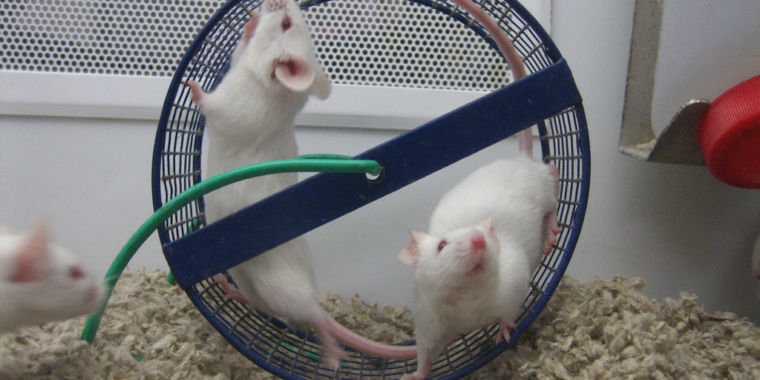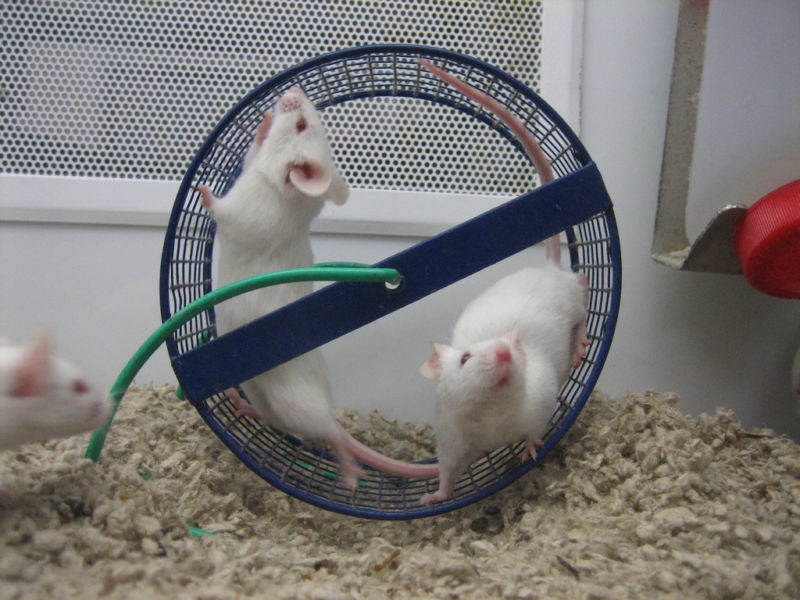

Gene drive is both a promising and disturbing technology. It allows us to engineer a stretch of DNA that, once inserted in a specific location in an organism’s genome, will convert other versions of the gene so that they also carry the insert. Once started in a population, gene drive will convert the entire population within a relatively short number of generations.
That’s promising, in that it opens the door to editing mosquitos to cause sterility to spread through a population, eliminating the spread of diseases and a fair bit of itching. But it’s also a genie that, once out of the bottle, appears to be impossible to put back—and hence is disturbing. But so far, there has been a small consolation: it has only been shown to work in insects.
Now, a large research team at the University of California, San Diego, has managed to get it working in mice. Sort of. It turns out that the efficiency is much lower. While the gene drive DNA is inherited at rates well above normal Mendel-style inheritance, it’s nowhere near as effective as in insects, and it’s not clear we know how to fix it.
What’s gene drive?
Gene drive depends on the ability to create a break in the DNA at a specific location in the genome. While we now have a variety of tools that can potentially do this, most have used the CRISPR/Cas-9 system, which is also used for gene editing. This system uses a combination of an RNA that matches a specific location in the genome (it can base-pair with one strand of the DNA’s double helix) and a protein that cuts the DNA at that location.
What happens next depends on the cell. Cells have two main ways of repairing DNA damage. One involves taking the two ends on either side of the break and sticking them back together. Typically, however, some of the DNA near the ends is lost as they’re put back together, creating a deletion at the site of the cut. The second involves identifying a similar DNA sequence and using that as a template for repair. This typically involves the other copy of the chromosome found in the cell, but it’s possible to inject similar DNA sequences that get used for repair instead.
This latter technique is how a gene drive construct is inserted into the genome in the first place. The researchers pick a target gene and then design an RNA that can cut its DNA. They then inject an RNA that targets it, along with the protein, to make the cut. In addition, they inject a lot of copies of some DNA that matches the gene they targeted but also contains an insertion of additional DNA. You can think of that DNA as the gene drive payload.
Typically, the payload will encode the two things that were just injected. In other words, it will encode an RNA that targets the same gene and a protein that will cut the gene. This won’t cut the engineered version of the gene, since the payload disrupts the sequence that the RNA matches. But it will cut the normal copy of the gene on the other chromosome. To repair that cut, the cell will use the copy that contains the payload. As a result, both copies of the chromosome will end up carrying the payload, and any offspring will inherit it. Those offspring will then see the process repeat, converting both of their chromosomes, causing the payload to rapidly spread through the population.
Mouse problems
That’s the way it works in insects, including fruit flies and mosquitos. But would something similar work in mice? The authors argue that getting it to work could be useful because it would allow researchers to engineer combinations of mutations that would be difficult to work with otherwise.
For their gene drive test, they chose to target a gene that is necessary for giving a mouse’s fur its color, making it easy to see if things worked. They also marked their gene drive payload, which they call CopyCat, with a gene that encodes a fluorescent protein. The payload also contained a guide RNA. But as a safety feature, it did not contain a DNA-cutting enzyme, meaning that had to be bred in separately. This prevents it from acting as a true, self-propagating gene drive system, while still allowing us to test whether such a system would work if it were packaged properly.
That also turned out to be useful because the DNA-cutting enzyme’s activity turned out to be the key to making an effective gene drive system. The researchers first set it up so that the gene would be active in all cells, but that turned out not to work. Rather than leading to the gene drive payload being copied onto a different chromosome, the fur color gene just ended up getting deleted. Apparently, the wrong kind of repair—the one that simply joins loose ends together—was active in some cells early in development.
So the researchers swapped in different chunks of DNA that caused the DNA-cutting enzyme to be active in different cells. When it was active in the male germ cells, it also created large deletions rather than converting the normal copy of the gene. The researchers eventually found success with a setup that had the enzyme active in female germ cells before the DNA was repaired using a copy with the gene drive payload.
Even then, the efficiency wasn’t great. In insects, you’d typically find that nearly every animal in the next generation ended up with two identical chromosomes carrying the gene drive construct. But in mice, the frequency was much lower, at about 72 percent. That’s a much higher percentage than would be possible through normal inheritance; the authors refer to the results as “super-Mendelian.” But it’s not efficient enough to allow the gene drive payload to sweep through a population at a hugely accelerated pace, though it could eventually get there.
The fear that this process could take over populations of mammals seems to await some improved technology. As the authors put it, “It appears that both the optimism and concerns are likely to be premature.”
What are the benefits? At this point, the authors’ stated goal of using the system to put together interesting combinations of mutations seems to be within reach. But there have been some suggestions of using it in populations of wild mice to eliminate their ability to carry some diseases or as part of an eradication effort where rodents have been an invasive species, like on remote islands. Both of these applications will also have to wait for a much higher efficiency version of the technology.
But it wouldn’t be possible to improve the technology if we couldn’t get it to work in the first place. Provided there’s future progress, this paper represents an important first step.
Nature, 2019. DOI: 10.1038/s41586-019-0875-2 (About DOIs).









